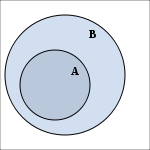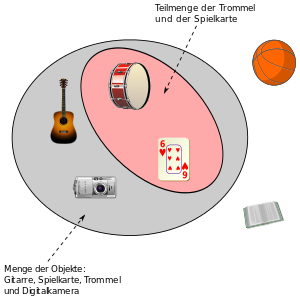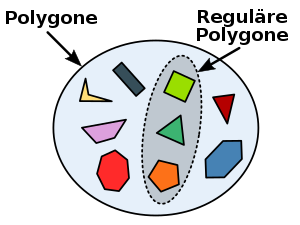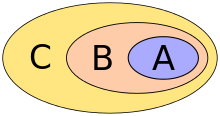Subset
The mathematical terms subset and superset describe a relationship between two sets. Another word for subset is subset.
For the mathematical mapping of the embedding of a subset into its basic set, the mathematical function of the subset relation, the inclusion mapping is used. 













The term subset was coined by Georg Cantor - the "inventor" of set theory - starting in 1884; the symbol of the subset relation was introduced by Ernst Schröder in 1890 in his "Algebra of Logic".

Set diagram: A is a (real) subset of B.
Definition
If 





Conversely, 

Furthermore, there is the notion of a real subset. 





Again, one also writes 

Other notations
⊂⊊⊆⊇⊋⊃
Some authors also use the characters 



Other authors prefer the characters 







Variants of the character 












The corresponding Unicode symbols are: ⊂, ⊃, ⊆, ⊇, ⊄, ⊅, ⊈, ⊉, ⊊, ⊋ (see: Unicode block Mathematical Operators).
Speech
Instead of " 














Examples
- {1, 2} is a (real) subset of {1, 2, 3}.
- {1, 2, 3} is a (fake) subset of {1, 2, 3}.
- {1, 2, 3, 4} is not a subset of {1, 2, 3}.
- {1, 2, 3} is not a subset of {2, 3, 4}.
- {} is a (real) subset of {1, 2}.
- {1, 2, 3} is a (real) superset of {1, 2}.
- {1, 2} is a (fake) superset of {1, 2}.
- {1} is not a superset of {1, 2}.
- The set of prime numbers is a real subset of the set of natural numbers.
- The set of rational numbers is a real subset of the set of real numbers.
More examples as set diagrams:
· 
A is a real subset of B
· 
C is a subset of B, but not a real subset of B

The set {drum, playing card} is a subset of the set {guitar, playing card, digital camera, drum}

The regular polygons form a subset of the set of all polygons.
Properties
- The empty set is a subset of each set:
- Every set is a subset of itself:
- Characterization of inclusion with the help of the association:
- Characterization of inclusion using the average:
- Characterization of inclusion using the difference set:
- Characterization of inclusion using the characteristic function:
- Two sets are equal if and only if each is a subset of the other:
This rule is often used when proving equality of two sets by showing mutual inclusion (in two steps).
- In the transition to complement, the direction of inclusion reverses:
- When forming the intersection, you always get a subset:
- When forming the union set, you always get a superset:
Inclusion as order relation
Inclusion as a relation between sets satisfies the three properties of a partial order relation, namely it is reflexive, antisymmetric and transitive:
(Where 


Thus, if 




If A ⊆ B and B ⊆ C, then also A ⊆ C
Inclusion Chains
If is 

![\{{]{-\infty, x}[} \mid x \in \R \}](https://www.alegsaonline.com/image/859ccfd71aa073323c9c536313a7e253b1cd8178.svg)

A special case of an inclusion chain exists if a (finite or infinite) set sequence is given which is ordered by 

Size and number of subsets
- Every subset of a finite set is finite and for the powers holds:
- Every superset of an infinite set is infinite.
- The same applies to the thicknesses for infinite sets:
- For infinite sets, however, it is possible for a real subset to have the same power as its base set. For example, the natural numbers are a real subset of the integers, but the two sets are equally powerful (namely, countably infinite).
- By Cantor's theorem, the power set of a set
always more powerful than the set
itself:
- A finite set with
elements has exactly
subsets.
- The number of
-elementary subsets of an
-elementary (finite) set is
given by the binomial coefficient
See also
- characteristic function
Search within the encyclopedia


















